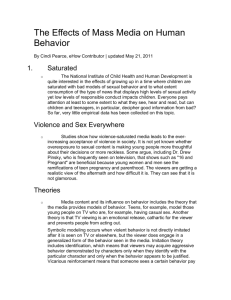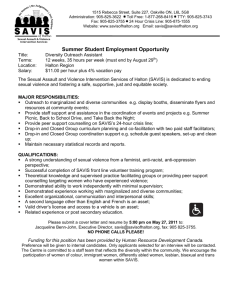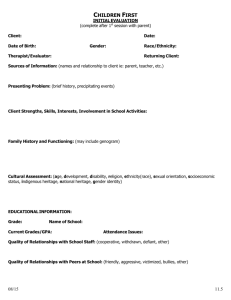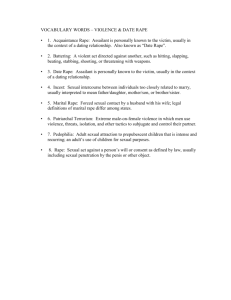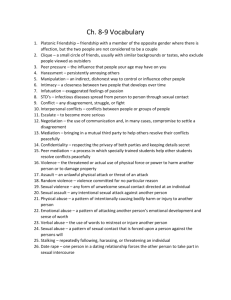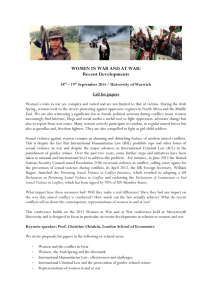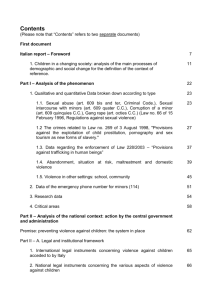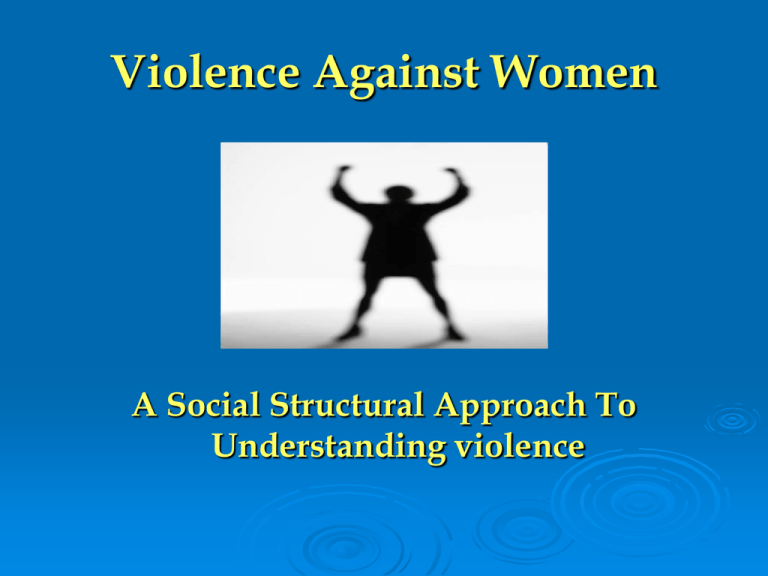
Violence Against Women
A Social Structural Approach To
Understanding violence
Childhood Sexual Abuse
A
sexual interaction between a child and
an adult or between two non adults in
which coercion is used.
Who are the Victims?
1-
Common in families in which members
are emotionally distant - without
intimacy, cohesion, or open displays of
affection.
2- Common in families with rigid,
traditional family structures.
3- Common in families with a number of
conflictual relationships, but especially
between family members.
Consequences for the Survivor
Immediate effects seen in children’s emotional, social,
cognitive and physical functioning.
As adolescents, they may be more likely to exhibit signs
of depression and social withdrawal and are also more
likely turn away from home, be sexually active, and to
contemplate suicide.
Most commonly reported psychological effects include
shame, guilt, fear, disgust, distrust, feelings of isolation,
hostile and aggressive feelings towards the perpetrator
and anxiety.
Courtship Violence
Refers
to aggression between unmarried
adolescents or young adults in dating
relationships.
Includes verbal aggression like screaming
and name calling to stalking and physical
violence involving the use of weapons.
Who Abuses?
Relationship Only perpetrators appear the most
‘normal’ and engage in only ‘mild’ psychological
and physical abuse and are not aggressive
outside the dating relationship.
The violent/antisocial type are usually male
and are likely to be aggressive inside as well
outside the dating relationship and to have
witnessed domestic violence and parental
physical punishment.
The histrionic/preoccupied type are usually
female and they are likely to have experienced
childhood sexual abuse and parental physical
punishment. In relationships, this type tends to
be intensely expressive, reactive and dependant.
Consequences of Courtship
Violence
lack
of motivation, low energy, poor
concentration, poor academic
performance, hyper arousal, substance
abuse, PTSD, depression, low self esteem,
eating disorders, as well as sexually risky
behaviours, unwanted pregnancy, and
sucidality.
Acquaintance Sexual Assault and
Rape
Refers
to instances in which one person
engages in sexual behavior against
another’s will.
This
includes unwanted sexual contact
like forced kissing or fondling to
attempted rape and rape.
Who Rapes?
Alcohol abuse, athletic affiliation and fraternity
membership are associated with sexual aggression
towards women among college men.
A history of family violence;
An early and varied sexual history including many
sexual partners;
A history of delinquency;
Acceptance of rape myths;
An impulsive personality;
Hedonistic and dominance motives for sex.
Lower than average sense of self worth;
Lower religiosity;
As well as peers who condone and encourage sexual
conquests.
Consequences for Women:
fear and anxiety, phobias, depression, diminished self esteem,
sexual dysfunctions, nightmares, and PTSD
alcohol or drug use and dependency and behavioral deviancy
injuries associated with the attack itself as well as chronic health
problems such as pelvic pain, excessive menstrual bleeding, vaginal
infections, gastrointestinal problems, headaches, std infections, and
possible pregnancy.
Other long term conditions include excessive weight loss, eating
disorders, substance abuse and sexual dysfunction.
Many rape victims feel helpless and devalued.
Women frequently feel guilty and blame themselves for the rape.
Rape Myths:
Rapists are strangers.
Only deviant men would consider
raping a woman.
Women ask to be raped; they could
avoid rape if they wanted to.
Women routinely lie about rape.
Pornography provides a safety valve or
catharsis that makes men less likely to
rape.
Sexual Harassment
“unwelcome sexual advances, requests for
sexual favors, and other verbal or physical
conduct of a sexual nature constitute sexual
harassment when 1- submission to such conduct
is made either explicitly or implicitly a term or
condition of an individuals employment; 2submission or rejection of such by an individual
is used as a basis of employment decisions
affecting such individual; or 3- such has the
purpose or effect of substantially interfering
with an individuals work performance or
creating an intimidating, hostile or offensive
work environment”. (EEOC, 1980).
Consequences for Women:
psychological symptoms including anxiety, depression,
decreased satisfaction with life, and symptoms of PTSD.
lowered self-esteem, self blame and impaired social
relationships.
College women who were sexually harassed report
feeling negative about themselves, their peers, their
professors and their campus and are more likely to leave
school without graduating.
Harassment at work is also associated with higher levels
of depression, absenteeism and a greater desire to leave
the company.
Why is Sexual Harassment an
Important Issue?
Sexual harassment emphasizes that men typically have more
power than women in our society.
Sexual demands are often coercive because women are offered
economic or academic advantages if they comply and harmful
consequences if they say no.
Sexual harassment dehumanizes women and treats them in a
sexist fashion; women are seen primary as sexual beings rather
than as intelligent and skilled employees or students.
Women are often forced to be silent victims because of fear and
the need to continue either in the workplace or at school.
If sexual harassment occurs in a public setting, without
condemnation from supervisor, many onlookers conclude that
sexist behavior is acceptable.
Wife Abuse
physical abuse can include hitting, kicking,
burning, pushing, choking and use of weapons
psychological/emotional abuse can include
humiliation, name calling, degradation,
intimidation, extreme jealousy, and refusal to
speak.
Another form of emotional abuse involves
finances when a man withholds money or takes
away money from his wife.
Who Batters?
Men who earn less than their wives.
Children who grew up in houses where the father beat
the mother are more likely to grow up and believe that
wife beating is ok.
Men who abuse are more likely to have been exposed to
physical violence and shaming by a parents as children
and to have developed insecure attachment early in life.
Are likely to be angry and aggressive and lack coping
skills
Consequences for Women:
fear, terror, and mistrust.
anxious and have low self esteem
suffer from bruises, cuts, burns and broken bones as a
result of assault
physiological problems like headaches, sleep
disturbances, extreme fatigue, abdominal pain, pelvic
pain, gynecological problems and other chronic
disorders.
Principles of Feminist Therapy (From
Matlin, p.411).
Women’s major problems are not internal, personal
deficiencies, instead, the problems are primarily societal
ones, such as sexism and racism.
Women and men should have equal power in their
social relationships.
Society should be changed to be less sexist; women
should not be encouraged to adjust to a sexist society by
being quieter and more obedient.
We must focus on women’s strengths, not on
characteristics that are presumed as deficiencies.
Women can then use these strengths to help
define and solve problems.
We must work to change these institutions that
devalue women including governmental
organizations, the justice system, educational
systems and the structure of the family.
Inequalities with respect to ethnicity, age, sexual
orientation, social class and disabilities should
also be addressed; gender is not the only
inequality.
Culture of Violence
“The act of violence is many things at once. At the
same instant it is the individual man acting out
relations of sexual power; it is the violence of a societya hierarchal, authoritarian, sexist, class-divided,
militarist, racist, impersonal, crazy society - being
focused through an individual man onto an individual
woman… These acts of violence are like a ritualized
acting out of our social relations of power: the stronger
dominate the weaker, the powerful and the powerless,
the active and the passive…the masculine and the
feminine” (Kaufman, 1987, p. 1).
http://www.michaelkaufman.com/
Culture of Rape
“What is a rape culture? It is a complex of
beliefs that encourages male sexual aggression
and supports violence against women. It is a
society where violence is seen as sexy and
sexuality as violent. In a rape culture women
perceive a continuum of threatened violence
that ranges from sexual remarks to sexual
touching to rape itself. A rape culture condones
physical and emotional terrorism against
women as the norm” (From the Preamble).
“The essential question for us is not whether men are
predisposed to violence, but what society does with
this violence. Why has the linchpin of so many
societies been the manifold expression of violence
perpetuated disproportionably by men? Why are so
many forms of violence sanctioned or even
encouraged? Exactly what is the nature of violence?
And how are patterns of violence and the quest for
domination built up and reinforced?” (Kaufman, 1987,
p. 4).
“Violence is an institutionalized form encoded into
physical structures and socioeconomic relations”
(Kaufman, 1987, p. 13).
Patriarchal Values and the Socialization of
Males
“Violence as an expression of the fragility of
masculinity and its place in the perpetuation of
masculinity and male domination…. But in
those who harbor great personal doubts or
strongly negative self images or who cannot
cope with a daily feeling of powerlessness,
violence against women can become a means
in trying to affirm their personal power in the
language of our gender - sex system. That these
forms of violence only reconfirm the negative
self image, and the feeling of powerlessness
shows the fragility, artificiality, and
precariousness of masculinity” (p. 17).
Learned Behavior
Law/Criminal Justice System
Media
Pornography
External Factors like Unemployment and
Alcohol Abuse
Poverty and Low Income
Psychology of Violence- i.e. War,
Environmentalism, Urbanization etc.
Native Communities and Increased
Violence against Women
“Many American Indians recreate the power structures
of the dominant culture. That is Indian men often have
privilege and authority over Indian women, and
Indian fathers and mothers have privilege and
authority over children, whereby each may exert
violence as a socially acceptable operation of Western
patriarchal power. Like other politically, economically,
and socially disempowered individuals in the
dominant culture then, American Indian man may
assert male authority violently in their homes and
communities against woman children.” (Poupart, p. 8).
Change?
According
to the feminist principles what
are some of thing things we can do to
change the culture of violence ?

